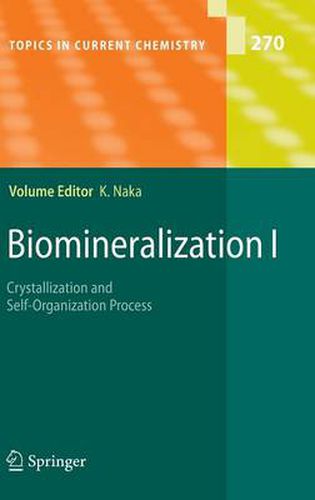Readings Newsletter
Become a Readings Member to make your shopping experience even easier.
Sign in or sign up for free!
You’re not far away from qualifying for FREE standard shipping within Australia
You’ve qualified for FREE standard shipping within Australia
The cart is loading…






This title is printed to order. This book may have been self-published. If so, we cannot guarantee the quality of the content. In the main most books will have gone through the editing process however some may not. We therefore suggest that you be aware of this before ordering this book. If in doubt check either the author or publisher’s details as we are unable to accept any returns unless they are faulty. Please contact us if you have any questions.
In nature, biological organisms produce mineralized tissues such as bone, teeth, diatoms, and shells. Biomineralization is the sophisticated process of production of these inorganic minerals by living organisms. Construction of organic-inorganic hybrid materials with controlled mineralization analogous to those produced by nature has recently received much attention because it can aid in understanding the mechanisms of the biomineralization process and development of biomimetic materials processing. The biomineralization ? processes use aqueous solutions at temperatures below 100 C and no toxic intermediates are produced in these systems. From a serious global en- ronmental problem point of view, the development of processes inspired by biomineralization would offer valuable insights into material science and en- neering to reduce energy consumption and environmental impact. One of the most challenging scienti?c problems is to gain greater insight into the mol- ular interactions occurring at the interface between the inorganic mineral and the macromolecular organic matrix. Model systems are often regarded as a straight-forward experimental approach toward biomimetic crystallization. Hierarchical architectures consisting of small building blocks of inorganic cr- tals are often found in biominerals. Studies of nanocrystal self-organization in solution systems would also be helpful for understanding biomineralization. In these volumes, we focus on construction of organic-inorganic hybrid - terials with controlled mineralization inspired by natural biomineralization. In the?rst volume, thereader will ?nd contributionsproviding abasic scopeof the mineralization process in aqueous solution.
$9.00 standard shipping within Australia
FREE standard shipping within Australia for orders over $100.00
Express & International shipping calculated at checkout
This title is printed to order. This book may have been self-published. If so, we cannot guarantee the quality of the content. In the main most books will have gone through the editing process however some may not. We therefore suggest that you be aware of this before ordering this book. If in doubt check either the author or publisher’s details as we are unable to accept any returns unless they are faulty. Please contact us if you have any questions.
In nature, biological organisms produce mineralized tissues such as bone, teeth, diatoms, and shells. Biomineralization is the sophisticated process of production of these inorganic minerals by living organisms. Construction of organic-inorganic hybrid materials with controlled mineralization analogous to those produced by nature has recently received much attention because it can aid in understanding the mechanisms of the biomineralization process and development of biomimetic materials processing. The biomineralization ? processes use aqueous solutions at temperatures below 100 C and no toxic intermediates are produced in these systems. From a serious global en- ronmental problem point of view, the development of processes inspired by biomineralization would offer valuable insights into material science and en- neering to reduce energy consumption and environmental impact. One of the most challenging scienti?c problems is to gain greater insight into the mol- ular interactions occurring at the interface between the inorganic mineral and the macromolecular organic matrix. Model systems are often regarded as a straight-forward experimental approach toward biomimetic crystallization. Hierarchical architectures consisting of small building blocks of inorganic cr- tals are often found in biominerals. Studies of nanocrystal self-organization in solution systems would also be helpful for understanding biomineralization. In these volumes, we focus on construction of organic-inorganic hybrid - terials with controlled mineralization inspired by natural biomineralization. In the?rst volume, thereader will ?nd contributionsproviding abasic scopeof the mineralization process in aqueous solution.